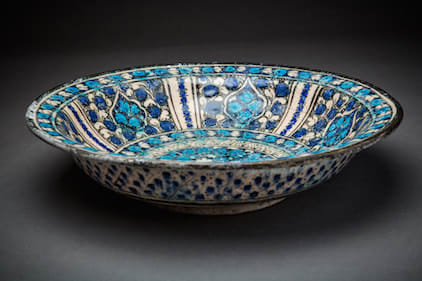Sultanabad Glazed Earthenware Bowl, 1300 CE - 1350 CE
Glazed Earthenware
13 x 3.1
GD.005R
Further images
The Mongol invasions of the Islamic world began in 1221, with the conquest of eastern Iran. However, a more devastating wave of conquest came with Genghis Khan’s grandson Hülegü. Establishing...
The Mongol invasions of the Islamic world began in 1221, with the conquest of eastern Iran. However, a more devastating wave of conquest came with Genghis Khan’s grandson Hülegü. Establishing rule over most of West Asia, he assumed the title of “Il-Khan”, meaning lesser Khan, subordinate to the Great Khan ruling in China. This branch of the Mongol dynasty, known as the Ilkhanids, centered its power in northwestern Iran between 1256 and 1353.
Although Mongol conquests initially brought devastation and affected the balance of artistic production, in a short period of time, the control of most of Asia by the Mongols, also known as Pax-Mongolica, created an environment of tremendous cultural exchange. The dynasty’s conversion to Islam saw the flourishing of Islamic art. East Asian elements absorbed into the existing Perso-Islamic repertoire created a new artistic vocabulary, one that was emulated from Anatolia to India, profoundly affecting artistic production and seen mainly on ceramics of this period.
Towards the end of the thirteenth century, a new type of underglaze ware was introduced in Central Asia. It is known today as "Sultanabad" ware. These wares were introduced into the region during the Ilkhanid period in the second half of the 13th century. They were probably made in the Arak area. This type of "Sultanabad" ware falls in one of three groups, the more colourful, using a cobalt-blue and occasionally turquoise.
This bowl is a perfect example of the “Sultanabad” ceramic style, named after the city in Western Iran that was long considered its place of origin. However, no pottery kiln has ever been found there.
Decorated in cobalt blue, turquoise and white relief with details outlined in black, this “Sultanabad” bowl depicts a seated bird just off centre in the cavetto. The bird is depicted against a reserve of foliage with a halo around its head which is unusual for an animal figure. Here, the decoration characteristically uses background scattered with small motifs. While the depiction of a halo in Islamic painting does not necessarily have the same spiritual connotations as in Western art forms, it is usually a sign of vital life force.
The shape of this dish with its flat rim and its upturned edge is copied from Chinese celadon ceramics that were a major item of trade to the Islamic world at this time. Celadon coloured pieces were made in this shape wit various decorative techniques. This dish however, is Islamic "Sultanabad" in every sense. The glazes are thicker than in the Chinese ware with darker richer colours painted under the glaze in dense patterns.
"Sultanabad" wares appeared under the Ilkhanid Dynasty and did not survive it. In the 14th century, the techniques and the motifs were imitated in Egypt and Syria, but with less pleasing results in that the colours were less dramatic.
This piece is therefore exceptional both for its rarity and its excellent condition.
Although Mongol conquests initially brought devastation and affected the balance of artistic production, in a short period of time, the control of most of Asia by the Mongols, also known as Pax-Mongolica, created an environment of tremendous cultural exchange. The dynasty’s conversion to Islam saw the flourishing of Islamic art. East Asian elements absorbed into the existing Perso-Islamic repertoire created a new artistic vocabulary, one that was emulated from Anatolia to India, profoundly affecting artistic production and seen mainly on ceramics of this period.
Towards the end of the thirteenth century, a new type of underglaze ware was introduced in Central Asia. It is known today as "Sultanabad" ware. These wares were introduced into the region during the Ilkhanid period in the second half of the 13th century. They were probably made in the Arak area. This type of "Sultanabad" ware falls in one of three groups, the more colourful, using a cobalt-blue and occasionally turquoise.
This bowl is a perfect example of the “Sultanabad” ceramic style, named after the city in Western Iran that was long considered its place of origin. However, no pottery kiln has ever been found there.
Decorated in cobalt blue, turquoise and white relief with details outlined in black, this “Sultanabad” bowl depicts a seated bird just off centre in the cavetto. The bird is depicted against a reserve of foliage with a halo around its head which is unusual for an animal figure. Here, the decoration characteristically uses background scattered with small motifs. While the depiction of a halo in Islamic painting does not necessarily have the same spiritual connotations as in Western art forms, it is usually a sign of vital life force.
The shape of this dish with its flat rim and its upturned edge is copied from Chinese celadon ceramics that were a major item of trade to the Islamic world at this time. Celadon coloured pieces were made in this shape wit various decorative techniques. This dish however, is Islamic "Sultanabad" in every sense. The glazes are thicker than in the Chinese ware with darker richer colours painted under the glaze in dense patterns.
"Sultanabad" wares appeared under the Ilkhanid Dynasty and did not survive it. In the 14th century, the techniques and the motifs were imitated in Egypt and Syria, but with less pleasing results in that the colours were less dramatic.
This piece is therefore exceptional both for its rarity and its excellent condition.







